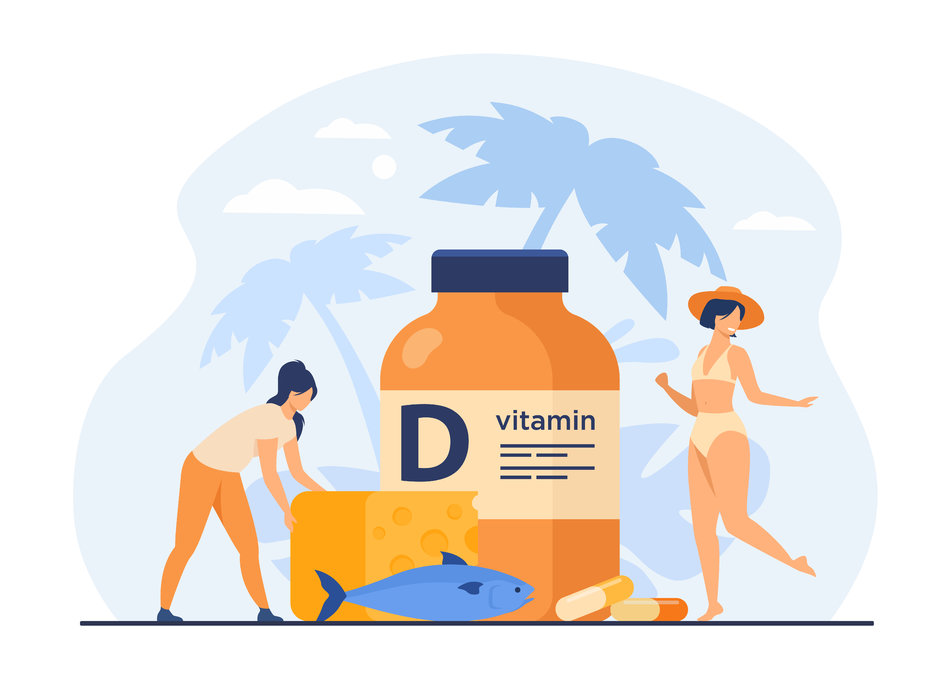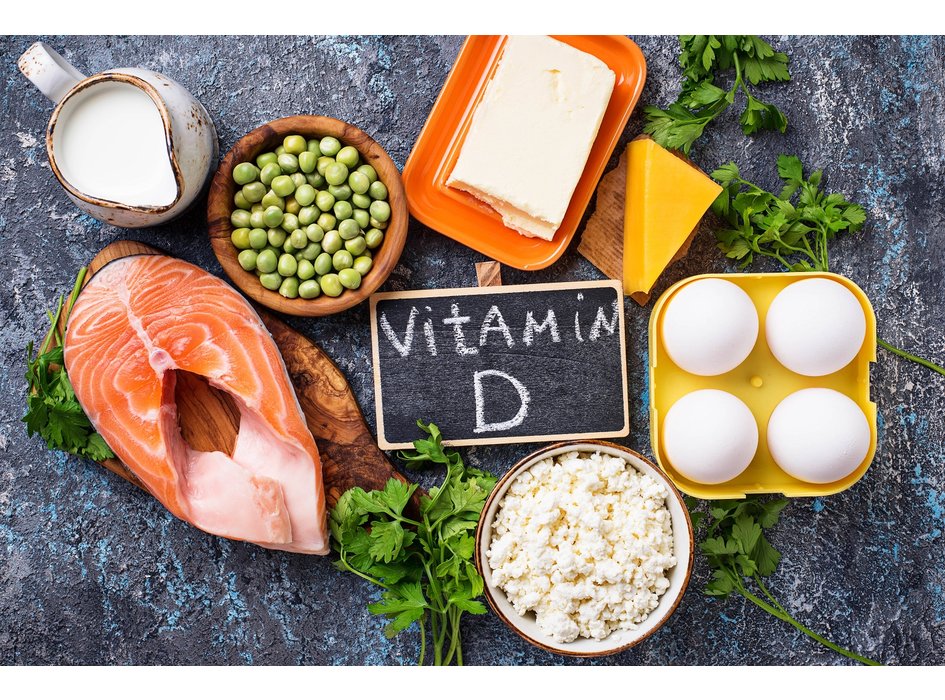Obsah
-
Sources of vitamin D
Foods rich in vitamin D
Nutritional supplements
Sunlight
How much is a sufficient intake of vitamin D?
What is the correct value of vitamin D in the blood?
Vitamin D3 deficiency
Is it possible to overdose on vitamin D?
Beneficial effects of vitamin D3
What is the difference between vitamin D and vitamin D3?
When should you take vitamin D3?
Is Vitamin D Really Necessary for Infants?
During the colder seasons, when we are less exposed to sunlight, our body often suffers from a lack of vitamin D. Due to the fact that very few foods contain it naturally, vitamin D3 in the form of nutritional supplements is an excellent helper for us in this period.

Sources of vitamin D
If you want to increase your vitamin D levels, you can take nutritional supplements, expose yourself to sunlight more often, or pay attention to the presence of this vitamin in your diet. It is difficult to get enough vitamin D3 only through diet, especially if it is not a diet rich in the foods listed below.
Foods rich in vitamin D

| Name of the food containing vitamin D |
Vitamin D content (IU / 100g) |
|
Cod liver oil |
1360 |
|
Cod liver |
10 000 |
|
Mothers milk |
0-10 |
|
Cow milk |
0,3 - 54 |
|
Cheese |
12 |
|
Eggs |
28 |
|
Cream |
50 |
|
Herring |
330 |
|
Salmon |
220 – 440 |
|
Sardines |
1500 |
|
Beef liver |
8 - 40 |
Nutritional supplements
They are the easiest way to ensure enough vitamin D3 every day. Many scientific studies show that vitamin D3 supplementation in the form of nutritional supplements is as effective as the natural one, obtained through sunlight or food.
Sunlight
In the case of the interaction of ultraviolet radiation B (UV B) from the sun and specialized cells - vitamin D receptors in human skin, a reaction associated with the production of vitamin is triggered.
On the other hand, care must be taken. Some experts recommend 10-15 minutes (several times a week) of unprotected sun exposure to maintain the required vitamin D levels. However, other studies suggest that there is no completely safe way to ensure adequate vitamin D intake from the sun without increasing the risk of skin cancer.

Therefore, it is appropriate to combine all three sources to the right extent - to expose yourself to a reasonable amount of sunlight in combination with the right nutritional supplements and a properly chosen diet. In this way, obtaining the required amount of vitamin D is safe, healthy and quite simple.
How much is a sufficient intake of vitamin D?
A sufficient dose of vitamin D cannot be strictly determined, as this amount depends on many factors - age, race, current season, exposure to sunlight, the area in which we live and the like.
The US Institute of Medicine recommends obtaining a minimum of 400-800 IU, which is 10-20 micrograms of vitamin D, and this dose should generally apply to 97.5 % of the population exposed to sunlight in standard amounts.
In one study involving healthy adults, they found that it was necessary to take 1120 to 1680 IU of the vitamin in order to get enough vitamin D levels.
The Institute of Medicine (IOM) considers 4000 IU to be a safe upper limit for vitamin D intake, so it is important to consult your doctor for higher intakes.
What is the correct value of vitamin D in the blood?
The values vary depending on the individual experts. Some consider a level higher than 20 ng / ml to be sufficient. Others believe that the level of vitamin D in the blood should never be lower than 30 ng / ml.
The IOM has established rules for measuring vitamin D in the blood as follows:
- Sufficient amount - more than 20 ng / ml (50 nmol / l), claiming that up to 97.5% of the population necessarily needs to have vitamin D levels higher than 20 ng / ml.
- Insufficient amount - less than 20 ng / ml (50 nmol / l).
- Deficiency - less than 12 ng / ml (25 nmol / l).
Vitamin D3 deficiency
Research shows that more than a billion people worldwide are deficient in vitamin D.
Symptoms and related conditions include:
- Muscle weakness and pain,
- weak bones,
- fatigue,
- hair loss,
- depression,
- hypertension,
- inflammation
- arthritis
- eczema.
Is it possible to overdose on vitamin D?
Vitamin D3 is generally safe and indeed very beneficial for the human body in the recommended amounts. However, if you take too much vitamin D3, it can have toxic effects.
Excessive intake of vitamin D3 can cause excessive absorption of calcium, which leads to a condition called hypercalcaemia (increased levels of calcium in the blood). A condition associated with reduced bone quality, impaired brain and heart function, and subsequently can lead to the formation of kidney stones.
The most common symptoms of vitamin D overdose include:
- Nausea
- Vomiting
- Muscle weakness
- Mood swings
- Pain
- Confusion
- Loss of appetite
- Dehydration
- Excessive urination
- Excessive thirst
Extremely high levels of vitamin D3 can lead to kidney failure, an irregular heartbeat, or even death.
Beneficial effects of vitamin D3
1. Healthy bones
Vitamin D significantly affects the absorption and regulation of calcium, and thus contributes to improving the condition of bones and muscles. If the human body suffers from vitamin D deficiency, the absorption of calcium is lower and the body is forced to obtain calcium from the bones, which leads to a decrease in their quality. In this case, the bones are weak and the risk of fractures or osteoporosis increases.
Research shows that vitamin D can significantly help reduce the incidence of fractures and increase muscle strength.

2. Respiratory system protection
Interest in the effect of vitamin D on the human respiratory system, its protective effect against respiratory diseases dates back to 1930, when a number of experts investigated the consumption of cod liver oil as a possible alternative in reducing the incapacity of factory workers due to respiratory infections of the upper respiratory tract.
Almost 100 years later, with the occurrence of the COVID-19 pandemic, there is a growing interest in studying the protective effects of vitamin D.
Some studies over the last decade have confirmed a mild protective effect of vitamin D against respiratory infections. Because of this, many experts are considering vitamin D supplementation as a possible prevention and effective helper in the treatment of new coronavirus disease.
During the pandemic caused by COVID-19, some preliminary evidence has emerged that vitamin D deficiency may increase the risk of infection. However, more work needs to be done to say with certainty what role (if any) this vitamin plays in combating the coronavirus that is causing this pandemic.
3. Immune system
Recent research at the University of Copenhagen has confirmed that vitamin D plays a key role in activating the human immune system (T cells) against viruses and bacteria.

To strengthen the immune system, especially in the autumn, when colder weather is a test for our immune system, it is appropriate to kick-off its functioning with the help of other effective nutritional supplements, which clearly include:
- L-lysine - an effective natural substance in the fight against viruses. It favorably supports the function of the immune system and helps prevent the outbreak of various viral infections.
- Colostrum - a nutrient that serves the first food of mammals during the first few hours after birth. It provides an irreplaceable combination of immune and growth substances that provide immune support and nutrition for the overall healthy development of the body.
- Lactoferrin - a substance with the ability to bind and transport iron, and thus have a positive effect on the immune system.
- Vitamin C - supports the immune system, detoxifies the liver and reduces oxidative stress.
4. Mood
Studies have shown that people with depression and anxiety often have vitamin D deficiency. However, it is not clear whether this deficiency contributes to depression or depression changes a person's behavior (eg eating habits, time spent outdoors), resulting in vitamin D deficiency.

5. Cancer
A number of studies have suggested the ability of vitamin D to act as a prevention of breast and prostate cancer. In the case of colon cancer, which is becoming more frequent, prevention options are also being discussed. Recent studies have confirmed that people with higher levels of vitamin D in their blood were significantly less prone to colon cancer.
6. Weight loss

Some studies suggest a link between obesity and low vitamin D levels. One of these studies even suggested that vitamin D supplementation in obese people in combination with reduced calorie intake could lead to easier weight loss.
7. Health of the cardiovascular system
Many studies have found a link between decreased levels of vitamin D in the blood and the incidence of obesity along with higher blood pressure. Some studies point to the ability of vitamin D to help lower blood pressure.
What is the difference between vitamin D and vitamin D3?
Vitamin D3 is a form of vitamin D known as cholecalciferol. It is found mainly in animal products - seafood, liver and eggs. In the human body, it is converted into a usable form of vitamin D.
When should you take vitamin D3?
Vitamin D3 is a fat-soluble vitamin, which means that it must be taken together with fat in order to make the best use of it. So it doesn't matter if you take it in the morning, in the afternoon or in the evening, provided you take it with food that contains a certain amount of fat.
The most effective is considered to be the liposomal form of vitamin D3, which is almost completely absorbed in the intestine, from where it travels to a designated place in the body.
Is Vitamin D Really Necessary for Infants?
Almost every newborn mother has a prescribed vitamin D on her prescription to prevent vitamin D deficiency, which is an important nutrient for the proper development of the baby's bones. With a high vitamin D deficiency, children are at risk of developing and developing symptoms of rickets, a disease that afflicted many poor children in the 19th century - feet up to the letter O, crooked spine, swollen ribs and wrists.

Many studies have looked at the function of vitamin D3 in the development of a child's brain. Many findings suggest that low maternal vitamin D3 does have an effect on the developing child's brain.
___________________________________________________________________________
RESOURCES
https://pubmed.ncbi.nlm.nih.gov/21118827/
https://pubmed.ncbi.nlm.nih.gov/12499343/
https://pubmed.ncbi.nlm.nih.gov/18541590/
https://www.pharmacytimes.com/view/august-2021-interactive-case-studies
https://www.casopisvnitrnilekarstvi.cz/pdfs/vnl/2020/08/06.pdf
https://onlinelibrary.wiley.com/doi/full/10.1111/j.1365-2567.2011.03482.x
https://www.sciencedirect.com/science/article/abs/pii/S030645220300040X
https://www.verywellhealth.com/vitamin-d3-5082500
https://www.medicalnewstoday.com/articles/161618#benefits
https://www.upjs.sk/public/media/16345/Bacova_prepracovany_clanok_cely_s_grafmi_(2).pdf
https://www.casopisvnitrnilekarstvi.cz/pdfs/vnl/2020/08/06.pdf
https://www.sysrevpharm.org/articles/vitamin-d3-for-health-and-muscle-functions-of-athletes.pdf


